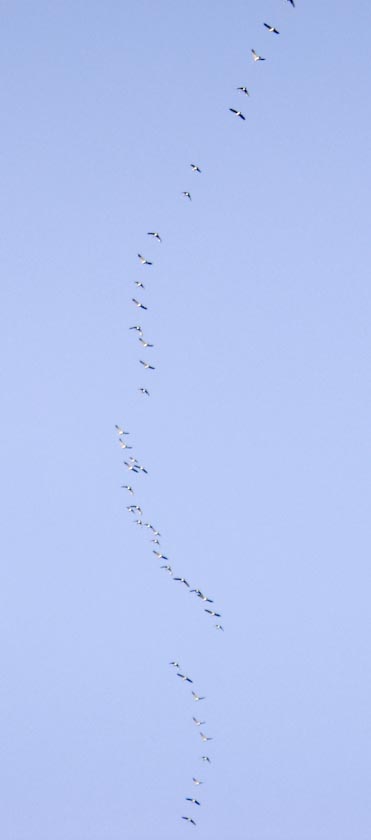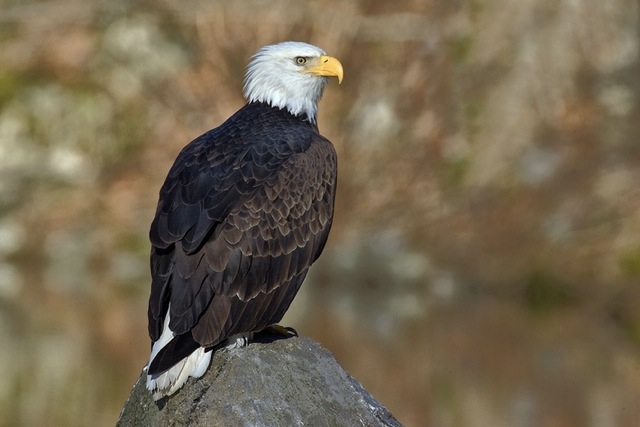

Photo courtesy of Save the Eagles International
For more information on the plight of Eagles, other Raptors, and birds internationally please visit
Save the Eagles International
Birds
These pages contain images of birds
and
links to
sites, research and information relating to the impact of IWT and
Industrialization on birds and their habitats.
 Sandhill Cranes migrating
|
 Photo courtesy of Save the Eagles International For more information on the plight of Eagles, other Raptors, and birds internationally please visit Save the Eagles International |
Mitigation?
What mitigation, we don't need no stinking mitigation!
To paraphrase Mel Brook's "Blazing Saddles" (1974)
Bird and raptor allowable mortality threshold rates in Ontario have been set equal to the highest ever recorded in North America. The Industrial Wind Generating Installation at Wolfe Island has consistently approached those thresholds in every reporting period since the plant started operating in May 2009. Birds killed include: birds listed as "threatened" (Chimney Swift & Bobolinks), raptors, and 25 other species of birds. To date Environment Canada and the Ontario Ministry of Natural Resources have recommended no mitigation actions other than ongoing monitoring. Presumably when all the raptors and other birds which migrate along this major migration route have had their numbers sufficiently reduced, the problem will be solved and no further mitigation will be necessary.
What can we expect the cumulative bird
mortality to be once Ostrander Point, Amherst Island, Wolfe Island
Shoals & 22 other
Industrial Wind Projects
to be constructed in the area come online? The MNR treats each
project in isolation and doesn't appear to consider the cumulative
effect of so many Industrial Wind Plants being constructed across a
major migratory flyway. They also don't consider the cumulative
effect on watersheds, erosion or the impact this Industrial
checkerboarding will have on the long term viability of Ontario's
biodiversity?
The
climate is variable. If nothing else has come from 12 years of
climate science, this has. No one disputes that the climate gets
warmer and colder over time. If our climate is indeed warming at
present (and there is some legitimate doubt about that), whether caused
by humans or nature or a combinaion of both, the accepted theory is
that in attempting to adapt to changing conditions our flora and fauna
will migrate from southern regions to more northerly regions. How
will the Industrial Checkerboarding of the Lake Superior watershed and
our boreal forest, which our Ontario Government wants to carpet with
thousands of IWT, help sustain biodiversity and allow our endangered
natural heritage adapt to a changing climate? The more wilderness
is fragmented the less carrying capacity it has and the greater the
percentage of its flora and fauna that become extirpated if not extinct
(1)
But
the Ministry of Natural Resources is not interested in such
considerations. The MNR's priorities are evident in the phrasing
to be found at the start of EBR postings related to the GEA and REA:
"Ontario
wants to make it easier for businesses to apply for and obtain
environmental approvals in a way that increases protection of the
environment. That's why we've created a new environmental approvals
process that will create a more efficient, user-friendly approach that
continues to fully protect the environment."
Note
that the priority is making it easier for business and more "efficient"
and "user friendly". The environment is last in both
sentences. Furthermore our environment is not currently 'fully'
protected. I'm also unsure how building hundreds of kilometers of
20m wide roads able of carrying 50 to 100 tons of equipment, clear
cutting hundreds of acres of carbon sink forest, disrupting wetlands
and spawning streams, and pouring hundreds of thousands of tons of
cement on which oil-leaking IWT, which catch fire, will be erected and
connected to the US export market via thousands of kilometers of new
high voltage transmission towers, which will have to be cut through our
untouched wilderness, "increases protection of the environment".
The latest Bird and Bat mortality reports for Wolfe Island can be found here and reports for previous years can be found here
Update 4 May 2011:
Wole
Island now has the highest raptor kill per turbine in all of North
America. The MNR's soution: another year of monitoring, the
last required of the project. We may well ask ourselves, then
what?
Thanks to Helen for this picture of Darryl Mueller in 1993, holding a Golden Eagle killed by an Industrial Wind Turbine at Altamont Pass, California, USA, another person who fought single-handed to protect eagles from turbines, in this case at Altamont Pass, for many years.
You can find Darryl's website here
The article can be found here
Habitat Fragmentation Effects on Birds in Grasslands and Wetlands: A Critique of Our Knowledge
Douglas H. Johnson
Abstract
Habitat fragmentation exacerbates
the problem of habitat loss for grassland and wetland birds. Remaining
patches of grasslands and wetlands may be too small, too isolated, and
too influenced by edge effects to maintain viable populations of some
breeding birds. Knowledge of the effects of fragmentation on bird
populations is critically important for decisions about reserve design,
grassland and wetland management, and implementation of cropland
set-aside programs that benefit wildlife. In my review of research that
has been conducted on habitat fragmentation, I found at least five
common problems in the methodology used. The results of many studies
are compromised by these problems: passive sampling (sampling larger
areas in larger patches), confounding effects of habitat heterogeneity,
consequences of inappropriate pooling of data from different species,
artifacts associated with artificial nest data, and definition of
actual habitat patches. As expected, some large-bodied birds with large
territorial requirements, such as the northern harrier (Circus
cyaneus), appear area sensitive. In addition, some small species of
grassland birds favor patches of habitat far in excess of their
territory size, including the Savannah (Passerculus sandwichensis),
grasshopper (Ammodramus savannarum) and Henslow's (A. henslowii)
sparrows, and the bobolink (Dolichonyx oryzivorus). Other species may
be area sensitive as well, but the data are ambiguous. Area sensitivity
among wetland birds remains unknown since virtually no studies have
been based on solid methodologies. We need further research on
grassland bird response to habitat that distinguishes supportable
conclusions from those that may be artifactual.
Key Words: birds, fragmentation, grasslands, habitat, wetlands, wildlife